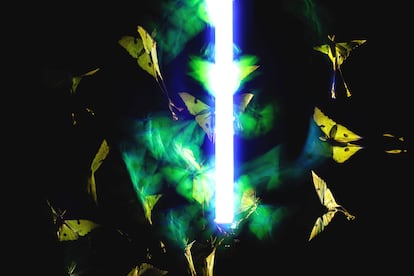The origin of a fatal attraction: Why mosquitoes and moths fly around light bulbs
A new study has discovered that artificial lighting confuses the orientation system of flying insects, who use sunlight to guide them

A familiar sight, especially in summer, is that of moths and mosquitoes gathered around light bulbs. The attraction of flying insects to lighting has long been known, so much so that there are written records dating from the Roman Empire describing the use of light to trap them. What remains unclear is why they do so. Previous scientific research has proposed that they interpret the flashes as an escape route, or that they are blinded by the light source. In a study published on January 30 in Nature Communications, the authors suggest that artificial light affects the insects’ ability to orient themselves correctly to the horizon, which could explain their behavioral change in the face of human illumination.
British zoologist Samuel Fabian, along with colleagues at Imperial College London, set up cameras in his garden to track the flight of a variety of moths, dragonflies, and fruit flies under different light conditions, including natural, artificial, ultraviolet, and direct and diffuse sources. They also analyzed them under laboratory conditions. They observed that when the animals were confronted with artificial light, they corrected their flight course so that their backs faced the light source — a phenomenon known as dorsal-light-response — and experienced dizziness and unexpected changes in their trajectory. In contrast, when the insects were exposed to the sun’s rays, they maintained a steady and orderly flight.
The dorsal-light-response, Fabian explains, is caused due to the fact that when flying “it is not always easy to determine which way is up.” Orientation is essential to insects, which guide their flight by a stabilization system based on turning their backs to the light to locate the sun or the most illuminated hemisphere, and thus decipher which is the sky and which is the ground. Artificial light generates confusion and causes them to tilt their bodies towards it, causing them to fly in circles, as is common to observe near streetlights.
Fabian, a researcher of insect behavior and physiology, remarks that this discovery changes the narrative of how insects become attracted to streetlights at night. “We don’t see insects going directly to lights because they simply love them, but because artificial light corrupts a behavioral mechanism that is probably older than the dinosaurs,” says the British scientist.
For Fabian, the next big question is the distance at which the effect begins to occur. The data currently available indicates that the disturbance occurs at about two meters around the light source: “We don’t know what is happening at 20 meters, 100 meters or 1,000 meters,” he notes, pointing out that understanding this would be crucial to reducing the effect of light pollution on nocturnal wildlife.

Negative effects
Endless orbiting around artificial light has a fatal outcome for these animals. They often fly to their deaths from exhaustion, lose their orientation and fall lethally to the ground, or become easier prey for predators. And this also has consequences for the environment.
Alejandro Sánchez de Miguel, an astrophysicist who studies light pollution at the Complutense University of Madrid, explains that habitat loss is the main cause of insect death. However, artificial light is also a risk factor and has several negative effects on them. For example, nocturnal insects abandon their vital functions because of the time they spend circling around light bulbs; and in diurnal insects, permanent lighting prolongs their period of activity for much longer.
The consequences also affect humans. Nighttime lighting attracts mosquitoes, who transmit diseases. In places where illnesses such as Nile fever or malaria are common, permanent lighting during the hours of darkness increases the number of cases.
Both the author of the study and the astrophysicist agree that insect habitats must be improved. Sánchez de Miguel recognizes that it is impossible to stop using lights in cities, but it is possible to consciously consume them to avoid unnecessary lighting at night. After all, as he points out, “altering natural conditions is never free.”
Sign up for our weekly newsletter to get more English-language news coverage from EL PAÍS USA Edition
Tu suscripción se está usando en otro dispositivo
¿Quieres añadir otro usuario a tu suscripción?
Si continúas leyendo en este dispositivo, no se podrá leer en el otro.
FlechaTu suscripción se está usando en otro dispositivo y solo puedes acceder a EL PAÍS desde un dispositivo a la vez.
Si quieres compartir tu cuenta, cambia tu suscripción a la modalidad Premium, así podrás añadir otro usuario. Cada uno accederá con su propia cuenta de email, lo que os permitirá personalizar vuestra experiencia en EL PAÍS.
¿Tienes una suscripción de empresa? Accede aquí para contratar más cuentas.
En el caso de no saber quién está usando tu cuenta, te recomendamos cambiar tu contraseña aquí.
Si decides continuar compartiendo tu cuenta, este mensaje se mostrará en tu dispositivo y en el de la otra persona que está usando tu cuenta de forma indefinida, afectando a tu experiencia de lectura. Puedes consultar aquí los términos y condiciones de la suscripción digital.
More information
Archived In
Últimas noticias
Mexican peso defies uncertainty with forecasts of a new period of stability in 2026
Meghan Markle’s year of redemption: Numerous projects, some setbacks and a brand that is finally taking off
David King, chemist: ‘There are scientists studying how to cool the planet; nobody should stop these experiments from happening’
The end of the American dream gives way to Guatemalan opportunity
Most viewed
- Sinaloa Cartel war is taking its toll on Los Chapitos
- Oona Chaplin: ‘I told James Cameron that I was living in a treehouse and starting a permaculture project with a friend’
- Reinhard Genzel, Nobel laureate in physics: ‘One-minute videos will never give you the truth’
- Why the price of coffee has skyrocketed: from Brazilian plantations to specialty coffee houses
- Silver prices are going crazy: This is what’s fueling the rally











































